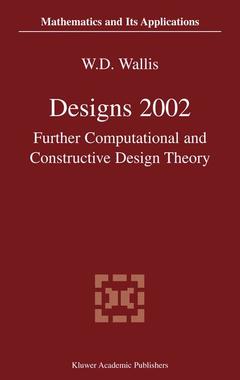Description
Designs 2002 (2nd Ed., 2nd ed. 2003)
Further Computational and Constructive Design Theory
Mathematics and Its Applications Series, Vol. 563
Coordinator: Wallis W.D.
Language: English
Subject for Designs 2002:
Keywords
algorithms; computer; construction; latin square; Notation; sets; combinatorics
Designs 2002 (2nd Ed.)
Publication date: 07-2012
368 p. · 15.5x23.5 cm · Paperback
Publication date: 07-2012
368 p. · 15.5x23.5 cm · Paperback
Designs 2002
Publication date: 09-2003
368 p. · 15.5x23.5 cm · Hardback
Publication date: 09-2003
368 p. · 15.5x23.5 cm · Hardback
Description
/li>Contents
/li>
This volume is a sequel to our 1996 compilation, Computational and Constructive Design Theory. Again we concentrate on two closely re lated aspects of the study of combinatorial designs: design construction and computer-aided study of designs. There are at least three classes of constructive problems in design theory. The first type of problem is the construction of a specific design. This might arise because that one particular case is an exception to a general rule, the last remaining case of a problem, or the smallest unknown case. A good example is the proof that there is no projective plane of parameter 10. In that case the computations involved were not different in kind from those which have been done by human brains without electronic assistance; they were merely longer. Computers have also been useful in the study of combinatorial spec trum problems: if a class of design has certain parameters, what is the set of values that the parameters can realize? In many cases, there is a recursive construction, so that the existence of a small number of "starter" designs leads to the construction of infinite classes of designs, and computers have proven very useful in finding "starter" designs.
1 The Existence of 2-SOLSSOMs.- 1 Introduction.- 2 Direct Constructions.- 3 Recursive Constructions.- 2 Conjugate Orthogonal Diagonal Latin Squares with Missing Subsquares.- 1 Introduction.- 2 Preliminaries.- 3 Direct Construction.- 4 Recursive Construction.- 5 A General Bound.- 6 The Case 2 ? n ? 6.- 3 Combinatorial Trades: a Survey of Recent Results.- 1 Introduction and Preliminaries.- 2 Trades in designs.- 3 Trades in latin squares.- 4 Trade uses.- 5 Latin representations and trades used in tripartite decompositions.- 6 ?-way trades.- 7 Graphical trades.- 8 Future directions.- 4 Two-stage Generalized Simulated Annealing for the Construction of Change-Over Designs.- 1 Introduction.- 2 Notation and Definitions.- 3 A Two Stage Generalized Simulated Annealing Algorithm.- 4 Performance of the Two-Stage GSA.- 5 New Lower Bounds on the Maximum Number of Mutually Orthogonal Steiner Triple Systems.- 1 Introduction.- 2 Starters over Finite Fields.- 3 Automorphisms and Hill-climbing.- 4 Conclusion.- 6 On minimal defining sets in AG(d, 3).- 1 Background.- 2 Introduction.- 3 Further Preliminaries.- 4 Proof of the Main Theorem.- 5 Sets of good hyperplanes in AG(d, 3).- 6 Related critical sets.- 7 Appendix.- 7 Hadamard Matrices, Orthogonal designs and Construction Algorithms.- 1 Algorithms for constructing Hadamard matrices.- 2 On inequivalent Hadamard matrices.- 3 Algorithms for constructing orthogonal designs.- 4 Short amicable sets and Kharaghani type orthogonal designs.- 8 Constructing a Class of Designs with Proportional Balance.- 1 Proportionally balanced designs.- 2 The method of construction.- 3 Feasible parameters for ? = 2, 3 and 4.- 4 Constructions motivated by Construction 5.- 9 Constructions Using Balanced n-ary Designs.- 1 Introduction.- 2 Balanced n-aryDesigns.- 3 Our Construction.- 4 Some Examples.- 5 Some Non-existence Results.- 6 An Improved Construction.- 7 Quadratic Residues.- 8 Another Improvement.- 9 An Application.- 10 More Difference Families.- 10 Sets of Steiner Triple Systems of Order 9 Revisited.- 1 Introduction.- 2 Large sets.- 3 Results.- 4 Uniformly intersecting sets.- 11 Solving Isomorphism Problems for t-Designs.- 1 Introduction.- 2 Basics.- 3 Moebius Inversions.- 4 Extensions of designs.- 12 Finding Double Youden Rectangles.- 1 Introduction.- 2 Definitions and Literature.- 3 Examples.- 4 Searching for a 13-cyclic 13 ? 40 DYR.- 5 Isomorphism.- 6 Further Properties of our new DYRs.- 7 Check for Balance.- 13 Kirkman Triple Systems and their Generalizations: A Survey.- 1 Introduction.- 2 Constructions for Kirkman Triple Systems and Nearly Kirkman Triple Systems for all admissible orders.- 3 Early Generalizations.- 4 Resolvable Packings and Coverings of v points where v ? 0 (mod 3).- 5 Other Generalizations.- 6 Conclusion and Acknowledgements.
© 2024 LAVOISIER S.A.S.



